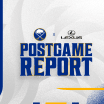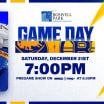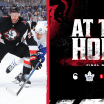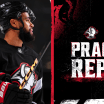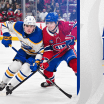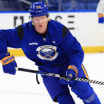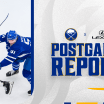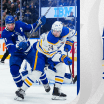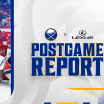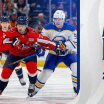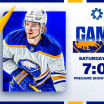As the 1974-75 season wore on, Punch Imlach decided the Sabres needed an upgrade in net. Roger Crozier was a former All-Star who gave the Sabres instant credibility upon joining the team for their inaugural season, but by 1974 a battle with pancreatitis had limited his availability. Crozier only 23 games in the regular season, leaving second-year goalie Gary Bromley to shoulder the load.
That changed in March with the acquisition of Gerry Desjardins. Desjardins had been playing for the Michigan Stags of the World Hockey Association - "probably the worst hockey team in the world," he says - but a clause in his contract allowed him to leave if the team relocated. It did, to Baltimore, midway through the season, and Imlach was quick to call.
1974-75: 'The fans were rocking'
Gerry Desjardins' favorite NHL moment came following a series victory over Montreal
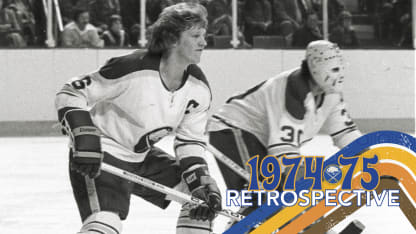
"He says, 'Would you be interested in signing with the Sabres?'" Desjardins said. "I almost dropped the phone. I couldn't believe what he was asking me. I says, 'Are you kidding me?'"
Desjardins came with NHL experience; before leaving for the WHA, he played six seasons for Los Angeles, Chicago, and New York. Joining a team already well on its way to the postseason, he also felt lofty expectations.
"It was fun coming to a great team, but I just felt - at the time I think there was like 15 games left in the season and everybody thought I was the ticket to the Stanley Cup back then," he said.
The road to the Cup began against a Chicago team that had finished with 82 points, third in the Smythe Division. The Sabres dispatched the Blackhawks in five games for their first series win in franchise history. Jim Schoenfeld remembers feeling like it was simply another checked box.
"I just looked at it as the first step," he said. "I really believed in the team. I thought we were going to win the Stanley Cup, so that was one opponent we had to get past. I wasn't shocked, surprised. I was certainly thrilled. … I guess, for lack of a better term, I kind of expected us to win that series."
Floyd Smith, the coach of the team, echoed that sentiment. "We were supposed to win that, and we did," he said.
There was, however, one moment from the series that lives in Smith's mind still today, and it involved the young captain Schoenfeld. The Blackhawks in those days featured a young, bruising defenseman named Phil Russell, a future Sabre who would go on to amass 2,038 penalty minutes during a 15-year career.
Schoenfeld fought Russell during the second period of Game 4, and Smith remembers the two men trading haymakers in one of the greatest fights he ever saw. Longtime broadcaster Rick Jeanneret still mentions it when asked about the best fights in Sabres history, saying it was so good that the officials stood to the side and watched.
"That turned our team right around," Smith said. "It didn't make us go from bad to good. It's just, 'Hey, we're here.' Simple as that."
Next up was a date with the Montreal Canadiens, a team that had beaten the Sabres two years prior. The Canadiens had already won the Stanley Cup twice in the '70s - in 1972 and '73 - and would go on to win four straight from 1976 to '79.
Montreal's roster in 1975 featured 11 future Hall of Famers and was coached by another in Scotty Bowman. The Canadiens earned 113 points - the same as the Sabres - to finish atop the Norris Division. Yet it was the Sabres who went undefeated with four wins and a tie in five regular season meetings.
"We had more Frenchmen than they did," Smith said. "We had good French players. They wanted to play against the Quebec team, and they played."
Gare scored in overtime to win Game 1, 6-5. The Sabres won again at The Aud in Game 2, were blown out in Games 3 and 4 in Montreal, then won another overtime contest in Buffalo in Game 5. Robert scored the winning goal.
It was Robert's second overtime goal in his playoff career. The first came in Game 5 against Montreal two years prior.
"When you look back over the history of this team," defenseman Mike Robitaille said, "if you had to go into a game in overtime and say it's predicated on, 'Whoever scores the first goal, that's it, game's over, you win the Stanley Cup. Buffalo, who do you want on the ice?' Well, I can think of many players. I would really have to give a lot of thought to putting Rene Robert on the ice. The bigger the game, the bigger the goal. He had a penchant for that. It wasn't luck. He was good.
The Sabres went back to Montreal and took Game 6, 4-3. Desjardins made 29 saves.
The team flew back to Western New York and landed in Niagara Falls rather than Buffalo. The thinking, Smith says, was that by landing in the Falls rather than their usual spot, they would avoid getting caught in too large a crowd.. When they landed, they were to hop on buses that would take them to their cars at the usual airport.
The crowd came anyway. Stories change as years pass, and it's difficult to pinpoint how many fans were waiting for the Sabres' plane on May 8, 1975. Fred Stanfield estimates there were 20,000 people. Schoenfeld says it might have been 5,000. But they all remember the crowd.
"That was sort of the magic of it," Schoenfeld said. "We were relatively new. We were the fresh faces in town at a very early time in franchise history, challenging for the big prize. The town was on fire for us. It really was. You couldn't have asked for better fan support than we had in Buffalo in the mid-70s."
"When we got on the bus, our wives were there," Desjardins said. "But I remember being on the bus almost being ready to leave, and the fans were rocking the bus. It was a little scary, but it was something to see."
Desjardins counts the victory as his fondest memory in the NHL.

